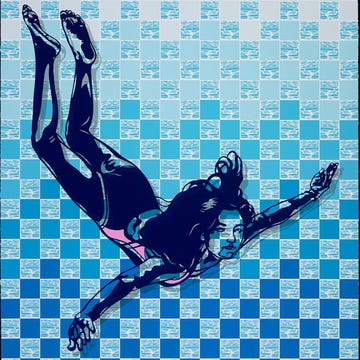In the driver’s seat of her red Toyota, Sophie Saldana (@sophiesophss) blends, chops, boils, and fries. Among other dishes, she’s cooked a branzino, birria ramen, fried sushi pizza, beef Wellington, and a complete Thanksgiving meal. Making and eating in the car can be confining and messy, both for Saldana and her vehicle’s interior. But the dripping and staining are actually good things, visual gold to Saldana’s more than 500,000 combined Instagram and TikTok followers, who love a satisfying close-up of ingredients, like stretchy cheese in a mozzarella stick.
In addition to chefing, Saldana is also a critic. This, too, she does from her car, joining a growing cohort of food influencers who review the latest fast foods from their dashboards. Cameras are suction-cupped to the front or side windows, and a tray (mostly off camera) attaches to the steering wheel. Influencers stuff their cupholders with Big Gulp–size containers of Cane’s sauce or ranch dressing, using straws to sip their dip after taking a bite. If there’s a new item on Taco Bell’s menu or at Wendy’s, these creators are chewing and posting on day one, rhapsodizing about items like Popeyes fried pickles as if they’re Michelin-starred delicacies.
Viral clips of people eating on camera began in the late aughts, when YouTubers in South Korea would record themselves scarfing down large quantities of food. This genre, also known as mukbang, was soon made popular with American audiences after the YouTube channel the Fine Brothers posted the 2015 video “YouTubers React to Mukbang (Eating Shows).” The video racked up millions of views.
It’s not clear when the recording booth migrated to the car seat. But the practice might have been born out of convenience, especially for California-based creators constantly weaving through traffic. “Eating in the car just feels real. It’s how many people actually eat fast food,” says Anastasia Zaichko, chief marketing officer at Famesters, an influencer marketing agency. “There’s something charmingly unpolished about it. There’s also a technical perk. The small space amplifies every crunch, crackle, and sauce squirt. It’s the sound of real eating, and viewers love it.”
As reviewers, mobile food influencers can occasionally be critical, but mostly, they’re here to entertain. “Tell me that don’t look good,” says Jerry Chen (@thejcheneats) in one video as he holds up a bite of his Korean barbecue from K-BoxBBQ. Chen cooks the meat in his vehicle on a small charcoal grill, stepping out only when he starts choking from the trapped smoke. He says his car smelled like barbecue for days after shooting the video. From the front seat of an electric Mini Cooper, Katie Molinaro (@eatitkatie) unpacks her Olive Garden meal, which includes two soups, a tub of Alfredo sauce, fried ziti, and salad. “And now for the pièce de résistance,” she says, holding up chicken Parm, lasagna, and fettuccine Alfredo in a black plastic container. If there’s one commonality among Molinaro’s 1.8 million TikTok subscribers, it’s that they trust social media to tell them where to eat. “[These videos] reflect the democratization of, quote, unquote, food reviewing, food criticism,” says Los Angeles Times food editor Daniel Hernandez. “I think really the job and the power is in the hands of the audience.”
Restaurants aren’t particular about the source of attention. In 2025, a TikTok segment can have more of an impact than a positive print review. “The restaurant industry needs all the love that it can get, and food influencers sharing the good word of their favorite spots to visit always helps,” says Tess Meza, executive coordinator at Howlin’ Rays, the beloved Nashville hot chicken spot in Los Angeles. “We think it’s great that folks have been able to share their love, whether that be from their car or dining in at the restaurant.”
Ellie (who declined to give her last name), a.k.a. @mukbangmami, has been creating food content for less than two years. At the moment, eating in her car is a side hustle—she also works in real estate. In her mid-20s, Ellie divides her time between Los Angeles and the Midwest. She has 7,000 followers on Instagram and more than 100,000 on TikTok. Ellie landed a paid partnership with DiGiorno Pizza in February, and she’s also experimented with food challenges to engage both her followers and fellow influencers. In April, she initiated a chili dog–eating challenge, calmly swallowing eight sausages while staring at the camera. She’d like to create content full-time but seems satisfied as a hobbyist for now. “The whole purpose is to communicate, to be happy when you’re eating,” she tells me.
In one of Ellie’s most popular videos, she’s in the passenger seat holding a white cardboard container emblazoned with the palm tree In-N-Out logo. The light in the car is a soft, warm yellow—unmistakably Southern California. Ellie digs into the pile of Animal Style fries with gusto, smears of a beige-orange spread sticking to the corners of her mouth. She looks happy, breaking into a little dance in the confined space before biting into a burger.
For Ellie and her colleagues, authenticity is the secret sauce: In their best videos, influencers appear as just a random person who pulled over to grab some grub, hit record on the iPhone, and began spilling and dribbling over a take-out box perched on their knees. And in California, what’s more real than eating in your car?•
Erik Himmelsbach-Weinstein is the director of communications for the California Native Vote Project. He spent more than five years as the senior director of video for sports and features for the Los Angeles Times and has worked as an editor at Spin, Los Angeles Reader, and Orange Coast. His work as a documentary writer-producer has appeared on VH1, ESPN, the Food Network, and NBC.















